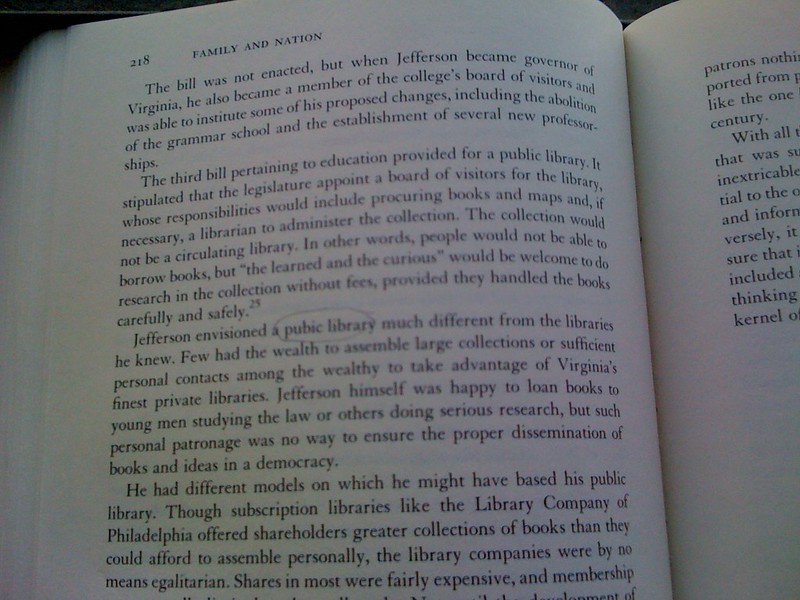The Devil in the White City: Murder, Magic, and Madness at the Fair That Changed America by Erik Larson. Recommended.
In The Devil in the White City, Erik Larson has turned what could be a dry retelling of the facts into a suspenseful story of creation, destruction, and insanity, focusing on architect Daniel Hudson Burnham, serial killer H. H. Holmes, and disturbed young man Patrick Eugene Joseph Prendergast. How will Burnham complete the 1893 World’s Columbian Exposition on time? In the midst of the world’s fair excitement, will anyone ever notice Holmes’ grisly career choice? What will Prendergast do and what does he have to do with the fair?
In chapters that roughly alternate, Larson exposes the characters of these individuals: the ambition and drive of Burnham, the amoral charm and bloodthirsty quest for psychological power of Holmes, and the obsessive insanity of Prendergast. While these stories are know to history, Larson is able to imbue them with suspense, showing the critical points at which the world’s fair nearly failed and the many obstacles that continually arose to obstruct it, the care with which Holmes planned his career and chose his victims, and Prendergast’s growing fascination with Chicago Mayor Carter Henry Harrison.
Unfortunately, Larson begins several strands that lead nowhere. After Burnham’s partner, John Root, dies, Larson hints that the opium addiction of Burnham’s new partner, Charles Atwood, will cause problems later, but never alludes to it again.
Larson also spends a great deal of effort on everything that impedes Frederick Law Olmsted’s implementation of the world’s fair landscape architecture plan, from temporary infrastructure such as rails to paths rutted after heavy rains. Despite extensive quoting of Olmsted’s concerns beyond the fair’s opening, Larson never reveals whether Olmsted’s plan was completed or, if not, the extent to which it was completed. At the end, while he describes Olmsted’s decline into dementia in great detail, I found myself wondering what the results were of Olmsted’s work on the world’s fair and not finding even a hint of an answer.
Another area that Larson builds on is Chicago’s desire to “out-Eiffel” Alexandre Gustave Eiffel and his Eiffel Tower. The result is the Ferris Wheel, which attracts thousands of visitors and makes $200,000 in profits. It’s never clear, however, whether the contemporary world perceived that Burnham and Ferris had succeeded in their quest.
In his conclusion, Larson omits some interesting details and gets others wrong. He mentions that the Palace of Fine Arts was transformed into a permanent building, home to the Museum of Science and Industry, but fail to mention that it was designed by Burnham’s opium-addicted partner, Charles Atwood. Indeed, Atwood is mentioned only twice. While noting that Olmsted’s lagoons and Wooded Island survive in Jackson Park today, he doesn’t allude to the other remnant of the fair that graces the park — a replica of the Statue of the Republic, fondly known as “Big Mary.”
His portrayal of Wooded Island as a “wild and tangled place” is only partially accurate. At the request of area nature lovers, the Chicago Park District stopped managing some areas, which are becoming “wild and tangled.” Visitors who cross the bridge, however, first behold a mowed lawn, while the Japanese garden is carefully, planted, pruned, and maintained — a fact that would surprise readers who go by Larson’s description.
Larson also talks about Burnham’s contribution’s to Michigan Avenue, Chicago’s “Miracle Mile.” The area is, of course, known more commonly as the “Magnificent Mile,” a phrase coined in 1947 by real estate developer Arthur Rubloff that is more suited to Burnham’s lofty aspirations. (“Miracle Mile” appears to be a recent marketing invention that most likely refers to the miracle it would take not to spend any money at the avenue’s many upscale shops and restaurants.)
Larson captures the era of rapid change and how a new type of American criminal, the antisocial serial killer, could take advantage of the time’s evolving mores and seeming indifference to mysterious disappearances. Burnham is incompletely portrayed; while he is shown to be a great architectural project manager who helped change the American idea of what a city could be, the reader is left with no sense of Burnham’s own architectural vision and style. Louis Sullivan’s criticism of the fair as relying on the past seems unfair based on Larson’s version of how the exposition was built; even had he wanted to be innovative, Burnham and his architects simply ran out of time. What would the exposition have looked like if Burnham had had another year?
Early visitors to the 1893 World’s Columbian Exposition felt a sense that the fair was incomplete, especially since the unfinished Ferris Wheel silently attested this impression. Careful readers will feel the same way about The Devil in the White City.
24 July 2004
Copyright © Diane L. Schirf


